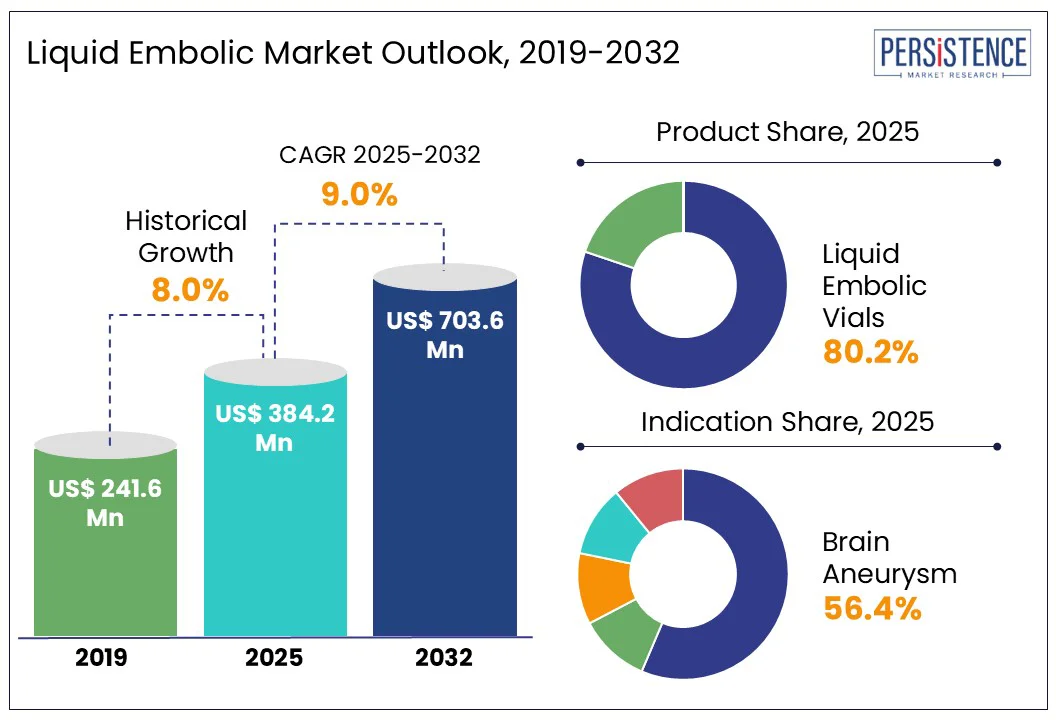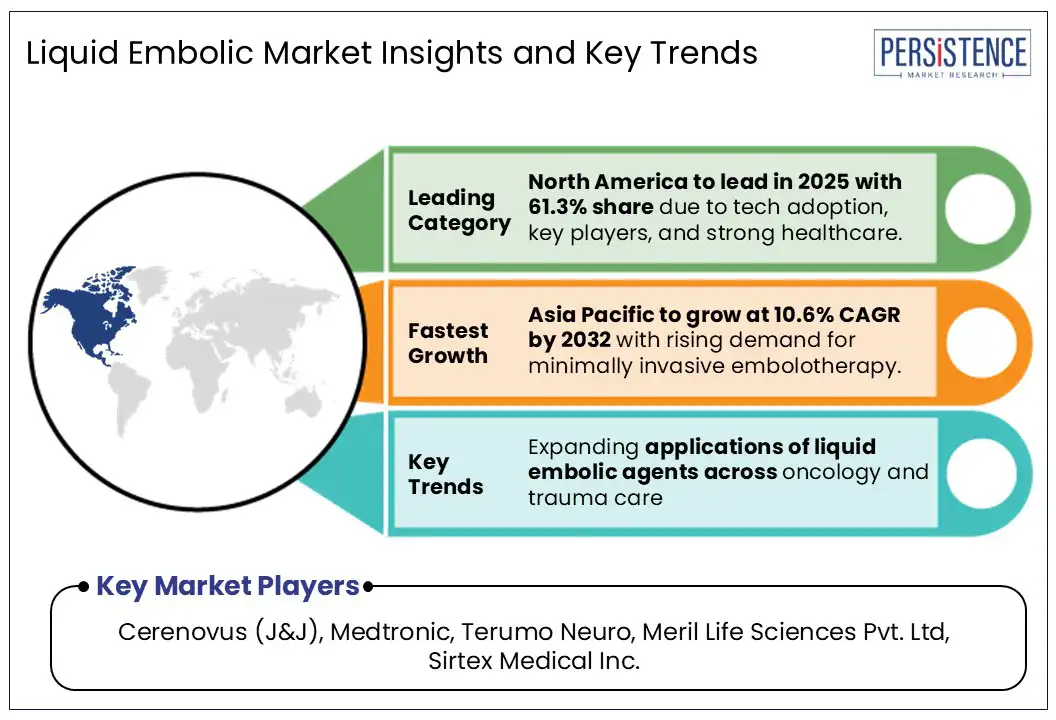ID: PMRREP25513| 200 Pages | 28 May 2025 | Format: PDF, Excel, PPT* | Healthcare

According to the Persistence Market Research report, the global liquid embolic market size is expected to reach US$ 703.6 Mn by from 384.2 Mn in 2025 at a CAGR of 9.0% by 2032.
Liquid embolic products have been used to treat arteriovenous malformations. While their use in the treatment of aneurysms is limited to a small group of patients, the most important concern is to prevent the migration of the liquid to the parent vessel. Despite this, demand for liquid embolics for aneurysm treatment remains significant, driven by growing indications for complex aneurysms, advancements in techniques, and improvements in embolic agent delivery systems.
 Key Industry Highlights
Key Industry Highlights
|
Global Market Attribute |
Key Insights |
|
Liquid Embolic Market Size (2025E) |
US$ 384.2 Mn |
|
Market Value Forecast (2032F) |
US$ 703.6 Mn |
|
Projected Growth (CAGR 2025 to 2032) |
9.0% |
|
Historical Market Growth (CAGR 2019 to 2024) |
8.0% |
Embolization is a minimally invasive procedure or treatment that has the potential to block one or more blood vessels or abnormal vascular channels. Various embolic agents are placed in certain ways, such as through catheters into the blood vessels, to inhibit blood flow to a specified area. The embolization procedure makes use of neurovascular embolization devices and products to discontinue bleeding or to inhibit the flow of blood to a tumor or abnormal area of tissue.
Liquid embolic agents are used widely in the embolization process because liquid formulations have a well-established role in the therapeutic embolization of blood vessels. Liquid embolic product demand is anticipated to increase at a substantial rate over the forecast period. Thus, the demand for liquid embolic vials is anticipated to remain significant throughout the forecast period as compared to that of liquid prefilled injectables.
Tumor embolization offers multiple opportunities due to the rising incidence of tumours globally. This minimally invasive process involves directing a small catheter into the feeding arteries of a tumor to shut down the blood supply to the tumor or deliver tumor-killing therapy directly to the tumor.
The growing prevalence of cancer, fueled by environmental and lifestyle factors, and variations in screening and diagnosis, expands the potential for tumor embolization. Additionally, embolotherapy during cancer treatment using the liquid embolic procedure offers a promising solution for younger patients. Increasing rates of obesity in adolescents and young adults also tend to add to rising chronic disease prevalence, such as diabetes, cardiovascular disease, and some forms of cancer. According to GLOBOCAN 2024, an estimated 19.97 million new cancer cases were detected in 2022.
Furthermore, growing demand for neurovascular embolization devices and neurosurgery, owing to the rising prevalence of cerebral aneurysm cases and associated risks such as neurological disorders and loss of cognitive functions, also adds to market growth globally.
As per the Cerebrovascular Society of India 2025 data, globally, two percent of all strokes are caused due to Arterio-Venous Malformations (AVMs), and two-thirds of this patient pool are under the age of 40.
Companies developing liquid embolic agents are expected to expand their market share and enhance their sales by pursuing regulatory approvals for indications beyond neuro interventional. Such expansion into new areas is likely to open additional revenue streams, leveraging advancements in technology and broadening the scope of liquid embolics' applications.
The risk associated with the liquid embolic procedure is very high, such as the chances of targeting the wrong blood vessels during surgical procedures. This can result in complications such as tissue necrosis, neurological damage, or non-target embolization. Precise and successful administration of liquid embolics demand advanced imaging and experienced interventionalists. This technical complexity limits the procedure’s accessibility and adoption in resource-constrained settings.
Further, there are a limited number of liquid embolic agent manufacturers due to intense competition from alternative transcatheter embolization devices, which is expected to limit liquid embolic systems market growth to some extent. Additionally, regulatory barriers pose further challenges in gaining approval for new liquid embolic formulations. This is likely to deter new entrants, limit innovation and restrict expansion into broader therapeutic indications, limiting the global liquid embolic market.
By product, liquid embolic vials are projected to lead the global liquid embolic market with a share of nearly 80.2% in 2025. Liquid embolic vial products provide ease of use for large volume treatments and require less storage space as compared to individual small volume vials. Also, the packaging of the liquid embolic vial is environmentally friendly. For instance, Onyx 34L LES comes in 6 ml vials with packaging made from 98% recyclable content. Thus, all these factors are set to fuel demand for liquid embolic vials during the forecast period.
Brain aneurysm is anticipated to lead the liquid embolic industry with 56.4% revenue share in 2025. This trend is expected to continue during the study period as well. High share of this segment is attributed to the high prevalence of aneurysms and the urgent need for effective treatment options.
Brain aneurysms are far more prevalent and urgent compared to other indications such as Brain Arterio-Venous Malformations (bAVM) or Dural Arteriovenous Fistulas (dAVFs). They often require complex embolization strategies, creating high demand for liquid embolics, especially in wide-neck or surgically inaccessible aneurysms.
Liquid embolic agents offer a minimally invasive approach for aneurysm management. Additionally, R&D and innovation are focused on aneurysm applications, further reinforcing their commercial dominance within the liquid embolic market.
Based on end-user, the hospitals are projected to lead the global liquid embolic market with 58.3% value share in 2025. A large number of people admitted to hospitals for the treatment of various diseases, such as cancer and cardiovascular diseases, is the reason behind the high revenue share of hospitals as far as liquid embolic products are concerned.

North America market is anticipated to hold a global market share of 61.3% in 2025 and is expected to continue experiencing great progress throughout the forecast period. The market is driven by several factors, including the presence of key players, high adoption rate of neurointerventional devices and high prevalence of cardiovascular and neurovascular diseases.
There has been a growing number of neurovascular surgeries in the U.S. over the past decade driven by advancements in endovascular techniques and improved patient outcomes. Furthermore, the expansion of ambulatory surgical centers (ASCs), specialized in neurovascular interventions, further supports the rising adoption of liquid embolic therapies in the region.
Europe is expected to hold around 21% of the global market for liquid embolics with the market expanding at a CAGR of nearly 8.6% over the forecast period. Within Europe, the share of Germany is very high due to the large number of clinical trials/research conducted in the country, especially in the cancer-related field.
For instance, according to EUREC, there are a total of 53 research ethics committees in Germany, out of which 33 are related to Faculties of Medicine/Universities, 17 are related to Medical Associations in the States, and 3 are related to States governments.
Thus, due to active participation of the government in research and innovation in the healthcare and cancer market, suppliers of liquid embolic products are expected to have a great opportunity to grow during the forecast period from 2025 to 2032.
Asia Pacific is projected to grow significantly at a CAGR of 10.6% over the forecast duration owed to growing demand for minimally invasive procedures and expanding access to advanced neurointerventional care.
The region faces a rising burden of neurological disorders in countries such as China and India, which together account for a significant share of global aneurysm and stroke cases. Recent studies reported the prevalence of unruptured cerebral aneurysms (UCAs) to be around 7% in Chinese adults aged 35 to 75 years.
Additionally, growing investments in medical technology and increasing medical tourism in Southeast Asia nations further accelerate the adoption of minimally invasive procedures such as embolotherapy
The global liquid embolic market is highly competitive. Followed by new product innovation, launches, and approvals have emerged as key growth strategies adopted by liquid embolic product providers. By focusing on these strategies, key stakeholders are expanding their geographic footprint and strengthening their existing product portfolios across geographies.
The global market is set to reach US$ 384.2 Mn in 2025.
The market is projected to record a CAGR of 9.0% during the forecast period from 2025 to 2032.
Increasing prevalence of neurological disorders, growing demand for minimally invasive procedures and high adoption rate of advanced embolic technologies.is expected to drive the global market.
Cerenovus (J&J), Medtronic, Sirtex Medical Inc., Terumo Neuro, and Meril Life Sciences Pvt. Ltd are a few leading players.
North America is projected to dominate the global market in 2025.
|
Report Attribute |
Details |
|
Historical Data/Actuals |
2019 – 2024 |
|
Forecast Period |
2025 – 2032 |
|
Market Analysis Units |
Value: US$ Mn/Bn Volume: Units |
|
Geographical Coverage |
|
|
Segmental Coverage |
|
|
Competitive Analysis |
|
|
Report Highlights |
|
|
Customization and Pricing |
Available upon request |
By Product
By Indication
By End-user
By Region:
Delivery Timelines
For more information on this report and its delivery timelines please get in touch with our sales team.
About Author